Snow causing house and home
problems in winter
Our Building Surveyors pride themselves on a high standard of work. We can carry out Building Surveys also known as Structural Surveys, Engineers Reports and Specific Defects Reports with regard to damp problems and building disputes. We can also carry out Independent Valuations. Note these are not for bank lending but are to advise you how much we feel the property is really worth. If you have a property problem we may even already have written an article on it and we would refer you to the many articles we have on our Free Property Articles web page.
Please Free phone us on 0800 298 5424 for a friendly chat.
Caveat Emptor
Snow and extreme weather can cause problems in your house. A well maintained house can make it easier to sell at the right price in the future. Remember that the buyer of your property will have a building survey carried out. This is because of what is known as Caveat Emptor meaning Buyer Beware.
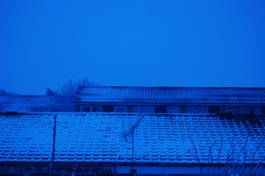
A typical snow covered house roof
Introduction
We are going to look at snow and the effect that we find it has on residential properties and particularly their roofs and floors. We will consider in our experience the problems that can arise which we have seen when carrying out surveys of properties due to snow fall.
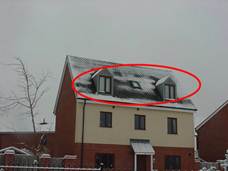
Snow is melting on the dormer roof
of a modern house. How well is a
modern house insulated?
Synopsis
We are going to look specifically at the problems and issues we have found with how snow affects the roofs of properties that we survey. We are also going to talk about experiences we have had with snow more generally and we will also advise you of any research that has been carried out in this area by learned institutes or bodies such as the Royal Institution of Chartered Surveyors (RICS), Building Research Establishment (BRE), we may even look at Wikipedia but we will not take it as gospel!
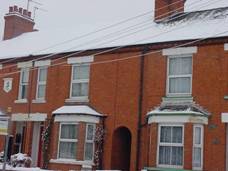
Snow on the roof of Victorian
terraced properties
Construction Summary
To give you a flavour of the property that we are going to be considering, here is the construction summary.
| Chimneys: | Two brick chimneys |
| Main Roof: | Pitched roof with a concrete tile covering |
| Gutters and Downpipes: | Original cast iron and plastic |
| Soil and Vent Pipe: | Plastic |
| Walls: | Flemish bond brickwork ( assumed) |
| External Joinery: | Sliding sash windows |
| Foundations: | Not inspected and known |
We have used the term assumed' as we have not opened up the structure.
As mentioned we are going to look at snow, we relate it back to a specific example that we have surveyed recently when someone was looking to purchase a property. This will show you just how important we think it is to have a building survey carried out.
Executive Summary
Executive summaries are always dangerous as they try and encapsulate relatively complex problems in a few precise and succinct words. Having said that here is our executive summary and recommendations:
For those short of time, and just as you will find in our building surveys, we have an Executive Summary here which identifies the main issues along with a brief explanation.
What is snow?
Snow is caused by a process called precipitation in the Earth's atmosphere. It creates crystalline ice so that snowflakes fall from clouds in granular form. It can vary in type i.e. (hard or soft and intensity). It all depends on the way the snow accumulates, the way it melts and refreezes and the rate at which it falls (it combines well with wind and rain making it even more dangerous).

Winter snow scene with field gate
Snow falls on land hills, mountains and rivers. Recently it has been said that the latter may increase the risk of flooding (Sky news). This also affects property and we discuss this in another article to do with April seasons. Snow affects human society transport buildings and infrastructure (Wikipedia).
In recent years snow has become more important in the news with winters becoming the coldest for 100 years (Daily Express), and in recent winters the snow has been inches deep (Daily Telegraph).
If you require any further help on snow please visit the following sites weather.org.uk, metcheck.com news, bbc.co.uk / weather.
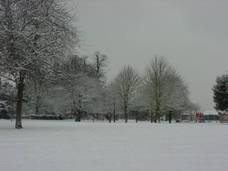
Heavy snow on roof of thatched
boxed timber frame property
The weight or the load of snow
One of the main problems for buildings is that snow creates a load which has to be calculated when designing a structure. It creates strain on domestic roofs and walls and then melts which allows moisture to enter inside.
Most of the roofs that are most likely to be affected by snow are residential but it can affect commercial buildings too. If you are interested in problems that snow can cause in commercial buildings and other property matters then the following articles may be of help to you:
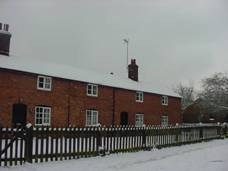
Stalactites hanging from a
thatched roof
Snow, what does it mean to residential buildings?
One of the key implications snow has is to cause extra load and dampness in residential homes. For example if we take a high pitch roof the snow creates extra weight which falls down the slope due to reduced friction with the tile. Snow moves toward gutters meaning that loads are transferred elsewhere and the problem is passed on! This can even occur on flat roofs of a conservatory for example.
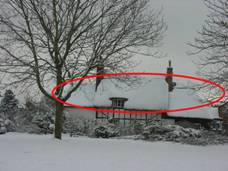
Heavy load of snow on roofs can
cause problems
Secondly if snow sits on roofs for long periods of time it can lead to water storage tanks and associated pipe work freezing in roof voids which can then burst and cause flooding.
In some cases gas pipes outside a house or electrical wiring can also be affected. Snow obviously means that more heating is required and can often lead to shortage of supply in your area.
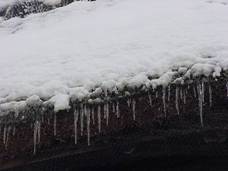
Stalactites hanging from a
thatched roof
Spalling brickwork
If snow sits on roofs it can melt and water can find its way in between roof tiles such as slate or concrete causing dampness in the upper rooms of your home. It can even find its way into brickwork which can freeze and eventually cause cracks on the face of the brick work which is known as spalling. In fact snow makes the problem worse which is originally caused by rain and frost.
If snow accumulates it can add to the problems of flooding that are occurring in parts of England as most weather forecasters are currently predicting. We have been on a variety of Surveys in which flooding has led to dampness in ground floor joists ( see survey findings below). This can lead to future decay and rot followed by expensive insurance claims (which we have found clients to have bad experiences with). However it is important to understand that snow can contribute to flooding!
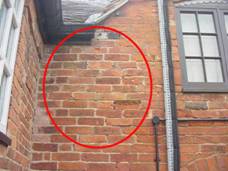
Spalling brickwork
Spalling Defined
Spalling occurs to brick or stone when water penetrates the surface and via freezing and thawing starts to cause deterioration to the surface. This in turn allows further water penetration and the surface breaks up further. This ultimately can lead to water damage or structural damage to the area.
Defects we have seen whilst surveying properties
Typical snow problems with the buildings we survey
We have witnessed roofs that are high pitched or very steep on which we can see snow creeping into roofs via gaps in roof tiling. Alternatively we find that snow slides easily down slate roofs where it then becomes trapped in guttering causing it to come away from its positioning or alignment.
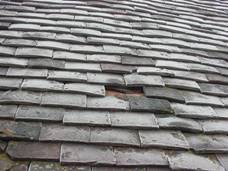
Snow can get into gaps in tiles and
cause dampness
How to solve these problems
In our experience the problems caused by snow have never been severe enough for us to recommend that the roof tiles or gutters are completely replaced! Indeed one roof we looked at should use preventative measures for snow, rather than repair or replacement, and just realign the gutters. Certainly this is far better than the proposal to use alternative roof tiles and replace the guttering and downpipes!
The biggest problems surrounding snow is the additional capacity that it imposes on a roof that can lead to deterioration of the guttering which we believe occurs due to the reduced friction between roofs and the snow. This causes snow to congregate at localised areas of the roof. This may be, for example, on the rainwater down pipe at the corner of a roof.
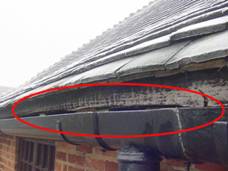
Gutters may need to be realigned
after heavy snow
Time Line, a brief history of roofs and guttering during successive years of snow
| 1800s onwards | Slate tiles were used for pitched roofs |
| 1950's | Concrete tiles started to be used for roofs |
| 1960's | Flat roofs introduced for extensions |
| 1970's | Plastic guttering replaced many cast iron gutters and downpipes but which are not as long lasting |
We would carry out two different types of inspection for snow on roofs and other parts of the building.
Firstly we would do a visual inspection both externally and internally.
Secondly, we could check with a damp meter to establish the condition of the timbers inside the roof.
This is really where wet rot occurs caused by the moisture of the snow. We can also check for moisture in joists using thermal imaging and or a similar damp test. We would also carry out a visual check of the utilities.
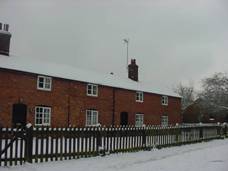
Gutters may need to be realigned
after heavy snow
Survey Findings
The sort of things we have found when looking at damage caused by snow are:
1. Snow overloading the capacity of gutters and down pipes therefore forcing them out of position.
2. The problem of snow load settling on roofs before melting and finding entry between gaps of tiles especially concrete tiles that sometimes do not interlock correctly leaving gaps for moisture to get in! If moisture settles on timber it can cause it to rot and eventually decay.
A similar problem can occur to floor joists (as in point 2 above) due to snow accumulating and settling outside ground levels to a property for long periods. This means it finds its way in under floors via gaps such as those provided by air bricks which are supposed to give ventilation to floor joists and are based on the external walls just above ground level.

Snow can enter airbrick and cause floor
joists to rot

Damp in floor joists
Summary Upon Reflection
A few final thoughts on snow on roofs:
If you do carry out an inspection yourself do remember that snow can make inspection very difficult and dangerous to enter voids in floors and upper areas of buildings. It is virtually impossible to see problems from ground level. You also need to look at other issues that could occur in the timber after the snow melts such as woodworm, wet rot and dry rot and this will require extensive monitoring afterwards.
The effect of snow on work, rest and play
Here are a few photos of how snow can affect our daily life.
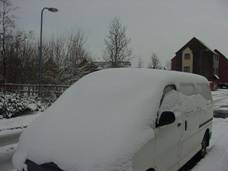
Car covered in snow, getting to work
can be difficult
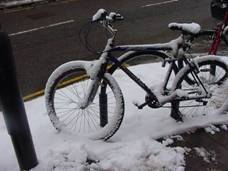
Cycling to work or school in snow
can be hazardous

Empty snow covered playground
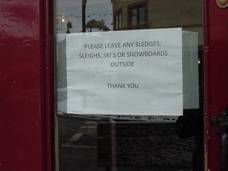
Sign on café door when it was
snowing

Remember the snow affects
wildlife. Feed the birds.
What do the circles and ovals mean?
The circles and ovals are a system that we use within our structural surveys and building surveys to highlight problem areas so that you are not left wondering what the problem is.

Icicles on a Victorian bay
Our Good, Bad & Ugly surveys!
We would also like to introduce to you what we call our good, bad and ugly survey which is a building survey also sometimes known as a structural survey. We have developed this over many years, in fact several decades. We have listened to feedback from our clients and amended and altered our surveys to make them easy to read and describe issues clearly. The key factor we believe is our surveys are easy to understand in plain English.
Examples of our building surveys
We are more than happy to provide you with examples of our unique building surveys via email. Our surveys contain photos, sketches and definitions that help to explain the specific problems that we find within the property. There is also an Executive Summary at the start of the survey report that highlights the main issues that we find with the property.
We trust you found the article of use and if you have any experiences that you believe should be added to this article that would benefit others, or you feel that some of the information that we have put is wrong then please do not pause to contact us (we are only human).
The contents of the website are for general information only and are not intended to be relied upon for specific or general decisions. Appropriate independent professional advice should be paid for before making such a decision.
All rights are reserved the contents of the website are not to be reproduced or transmitted in any form in whole or part without the express written permission of www.1stAssociated.co.uk
References
dailyexpress.co.uk
dailytelegraph.co.uk
Malcolm Hollis Surveying Buildings, The fifth edition, RICS books
Sky news
